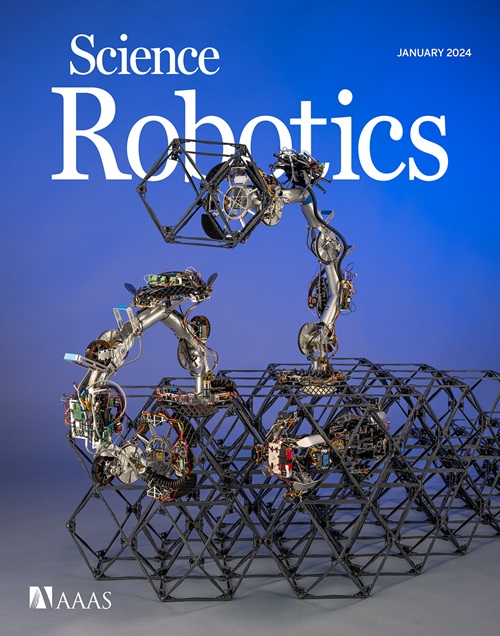Reverse engineering the control law for schooling in zebrafish using virtual reality
IF 27.5
1区 计算机科学
Q1 ROBOTICS
引用次数: 0
Abstract
Revealing the evolved mechanisms that give rise to collective behavior is a central objective in the study of cellular and organismal systems. In addition, understanding the algorithmic basis of social interactions in a causal and quantitative way offers an important foundation for subsequently quantifying social deficits. Here, with virtual reality technology, we used virtual robot fish to reverse engineer the sensory-motor control of social response during schooling in a vertebrate model: juvenile zebrafish (Danio rerio). In addition to providing a highly controlled means to understand how zebrafish translate visual input into movement decisions, networking our systems allowed real fish to swim and interact together in the same virtual world. Thus, we were able to directly test models of social interactions in situ. A key feature of social response is shown to be single- and multitarget-oriented pursuit. This is based on an egocentric representation of the positional information of conspecifics and is highly robust to incomplete sensory input. We demonstrated, including with a Turing test and a scalability test for pursuit behavior, that all key features of this behavior are accounted for by individuals following a simple experimentally derived proportional derivative control law, which we termed “BioPD.” Because target pursuit is key to effective control of autonomous vehicles, we evaluated—as a proof of principle—the potential use of this simple evolved control law for human-engineered systems. In doing so, we found close-to-optimal pursuit performance in autonomous vehicle (terrestrial, airborne, and watercraft) pursuit while requiring limited system-specific tuning or optimization.

利用虚拟现实技术对斑马鱼鱼群控制规律进行逆向工程
揭示引起集体行为的进化机制是细胞和生物系统研究的中心目标。此外,以因果和定量的方式理解社会互动的算法基础,为随后量化社会缺陷提供了重要基础。在这里,我们利用虚拟现实技术,用虚拟机器鱼来逆向工程在一个脊椎动物模型:幼斑马鱼(Danio rerio)的社会反应的感觉-运动控制。除了提供一种高度可控的方法来了解斑马鱼是如何将视觉输入转化为运动决策的,我们的系统网络还允许真正的鱼在同一个虚拟世界中游泳和互动。因此,我们能够直接在现场测试社会互动模型。社会反应的一个重要特征是单一目标导向和多目标导向的追求。这是基于一个自我中心的位置信息的表示,是高度鲁棒的不完整的感官输入。通过图灵测试和追踪行为的可扩展性测试,我们证明了这种行为的所有关键特征都是由个体按照一个简单的实验推导的比例导数控制律来解释的,我们称之为“BioPD”。因为目标追踪是自动驾驶汽车有效控制的关键,我们评估了——作为原理证明——这种简单进化的控制律在人类工程系统中的潜在应用。在这样做的过程中,我们发现在需要有限的系统特定调整或优化的情况下,自动驾驶车辆(陆地、空中和水上)的追踪性能接近最佳。
本文章由计算机程序翻译,如有差异,请以英文原文为准。
求助全文
约1分钟内获得全文
求助全文
来源期刊

Science Robotics
Mathematics-Control and Optimization
CiteScore
30.60
自引率
2.80%
发文量
83
期刊介绍:
Science Robotics publishes original, peer-reviewed, science- or engineering-based research articles that advance the field of robotics. The journal also features editor-commissioned Reviews. An international team of academic editors holds Science Robotics articles to the same high-quality standard that is the hallmark of the Science family of journals.
Sub-topics include: actuators, advanced materials, artificial Intelligence, autonomous vehicles, bio-inspired design, exoskeletons, fabrication, field robotics, human-robot interaction, humanoids, industrial robotics, kinematics, machine learning, material science, medical technology, motion planning and control, micro- and nano-robotics, multi-robot control, sensors, service robotics, social and ethical issues, soft robotics, and space, planetary and undersea exploration.
 求助内容:
求助内容: 应助结果提醒方式:
应助结果提醒方式:


